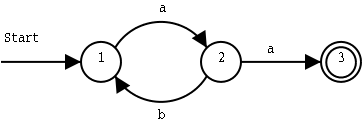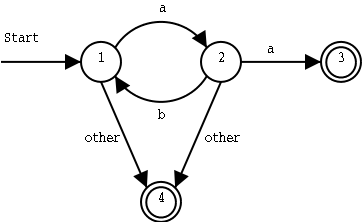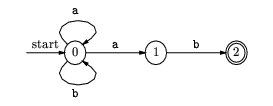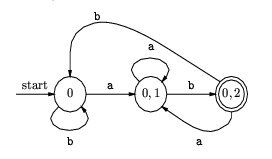
Today:
Lexical analysis ("scanning"). Lex.
ASU 3.1-3.5. KP chapter 2.
Thomas Niemann:
A Compact Guide to Lex & Yacc
(this time only the Lex parts).
See also A Compact Guide to Lex & Yacc, click on Lex and then Practice.
letter ( letter | digit )*Why not:
letter ( letter* | digit* )Example 2: Unsigned numbers (17, 5.0, 6.23E-23)
digit -> 0 | 1 | 2 | ... | 9
digits -> digit digits*
optional_fraction -> . digits | empty
optional_exponent -> ( E ( + | - | empty ) digits | empty
num -> digits optional_fraction optional_exponent
See also A Compact Guide to Lex & Yacc, click on Lex and then Theory.
Finite state automaton = finite state machine = finite automaton (in Swedish: ändlig tillståndsmaskin = ändlig tillståndsautomat = ändlig automat). A FSA can be in one of several states:

It is called finite (Swedish: "ändlig") since it only has a finite (Swedish: ändligt) number of states.
We add some transitions, or edges (Sw: bågar) that lets the machine change state from one state to another:

In a deterministic finite state automaton, or DFA (Swedish: deterministisk tillståndsmaskin) transitions are determined by some sort of input:

We move from state 1 to state 2 if we get an a as input. From state 2, we move back to state 1 if we get a b as input, and we move on to state 3 if we get an a.
To get from the start state to the end state, we must get an input string that starts with an a, and then has zero or more ba pairs. As soon as we get two a in a row, we move to the end state. These strings will work:
a(ba)*aIf other input symbols than a and b can occur in the input, we should handle them too. We add a fourth state, which is also an end state, and were we will arrive as soon as we find anything else than a and b in the input:

A non-deterministic finite state automaton, or NFA (Swedish: icke-deterministisk tillståndsmaskin, icke-deterministisk automat), can have the same label on several transitions from a state. Try all of them at the same time. So a NFA can be in several different states at the same time!
Regular expressions easier to express with a NFA than with a DFA. A NFA can always be transformed to a DFA.
The NFA for (b|a)*ab (from KP page 37):

Can be transformed to:

Again, the example with the format of an identifier:
letter ( letter | digit )*Figure 2-1 from Niemann:

An implementation:
start: goto state0
state0: read c
if c = letter goto state1
goto state0
state1: read c
if c = letter goto state1
if c = digit goto state1
goto state2
state2: accept string
%{Simple example, that just copies characters:
C declarations
%}
Lex definitions
%%
rules
%%
subroutines
%%
/* match everything except newline */
. ECHO;
/* match newline */
\n ECHO;
%%
int yywrap(void) {
return 1;
}
int main(void) {
yylex();
return 0;
}
Another example:
|
Lex token spec for Niemann's calculator:
|
Pattern Matching Primitives in Lex (Table 2-1 from Niemann):
| Metacharacter | Matches |
|---|---|
. |
any character except newline |
\n |
newline |
* |
zero or more copies of the preceding expression |
+ |
one or more copies of the preceding expression |
? |
zero or one copy of the preceding expression |
^ |
beginning of line |
$ |
end of line |
a|b |
a or b |
(ab)+ |
one or more copies of ab (grouping) |
"a+b" |
literal "a+b" (C escapes still work) |
[] |
character class |
Pattern Matching Examples from Lex (Table 2-2 from Niemann):
| Expression | Matches |
|---|---|
abc |
abc |
abc* |
ab abc abcc abccc ... |
abc+ |
abc, abcc, abccc, abcccc, ... |
a(bc)+ |
abc, abcbc, abcbcbc, ... |
a(bc)? |
a, abc |
[abc] |
one of: a, b, c |
[a-z] |
any letter, a through z |
[a\-z] |
one of: a, -, z |
[-az] |
one of: - a z |
[A-Za-z0-9]+ |
one or more alphanumeric characters |
[ \t\n]+ |
whitespace |
[^ab] |
anything except: a, b |
[a^b] |
a, ^, b |
[a|b] |
a, |, b |
a|b |
a, b |
Lex variables and functions (Table 2-3 from Niemann):
| Name | Function |
|---|---|
int yylex(void) |
call to invoke lexer, returns token |
char *yytext |
pointer to matched string |
yyleng |
length of matched string |
yylval |
value associated with token |
int yywrap(void) |
wrapup, return 1 if done, 0 if not done |
FILE *yyout |
output file |
FILE *yyin |
input file |
INITIAL |
initial start condition |
BEGIN condition |
switch start condition |
ECHO |
write matched string |
If your program has a large collection of reserved words, it is more efficient to let lex simply match a string, and determine in your own code whether it is a variable or reserved word. For example, instead of coding
"if" return IF;
"then" return THEN;
"else" return ELSE;
{letter}({letter}|{digit})* {
yylval.id = symLookup(yytext);
return IDENTIFIER;
}
where symLookup returns an index into the symbol table, it is better
to detect reserved words and identifiers simultaneously, as follows:
{letter}({letter}|{digit})* {
int i;
if ((i = resWord(yytext)) != 0)
return (i);
yylval.id = symLookup(yytext);
return (IDENTIFIER);
}
This technique significantly reduces the number of states required,
and results in smaller scanner tables.
Later: